 W
WAegirine is a member of the clinopyroxene group of inosilicate minerals. Aegirine is the sodium endmember of the aegirine-augite series. Aegirine has the chemical formula NaFeSi2O6 in which the iron is present as Fe3+. In the aegirine-augite series the sodium is variably replaced by calcium with iron(II) and magnesium replacing the iron(III) to balance the charge. Aluminium also substitutes for the iron(III). Acmite is a fibrous, green-colored variety.
 W
WAkaganeite, also written as the deprecated Akaganéite, is a chloride-containing iron(III) oxide-hydroxide mineral, formed by the weathering of pyrrhotite (Fe1−xS).
 W
WAlterite is a yellow-green mineral with the chemical formula Zn2Fe3+4(SO4)4(C2O4)2(OH)4·17H2O. Its type locality is Coconino County, Arizona. It is found exclusively in logs that have mineralized.
 W
WAluminocopiapite is an aluminum iron sulfate mineral with the chemical formula Al2/3Fe3+4(SO4)6(OH)2·20H2O. Its type localities are Fortymile River in Alaska and the San Rafael Swell in Utah.
 W
WAmarantite is an amaranth-red to brownish mineral with the general formula of Fe3+2O(SO4)2·7H2O or Fe3+SO4(OH)·3H2O.
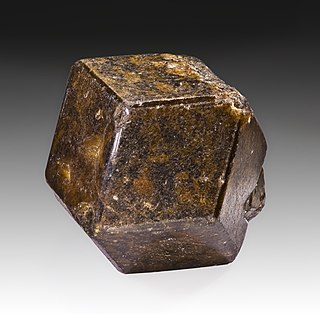 W
WAndradite is a species of the garnet group. It is a nesosilicate, with formula Ca3Fe2Si3O12.
 W
WArgentojarosite is an iron sulfate mineral with the chemical formula AgFe3+3(SO4)2(OH)6. It is one of few iron sulfate minerals containing silver in its chemical formula as a dominant element. Its type locality is the East Tintic Mountains, Utah.
 W
WArthurite is a mineral composed of divalent copper and iron ions in combination with trivalent arsenate, phosphate and sulfate ions with hydrogen and oxygen. Initially discovered by Sir Arthur Russell in 1954 at Hingston Down Consols mine in Calstock, Cornwall, England, arthurite is formed as a resultant mineral in the oxidation region of some copper deposits by the variation of enargite or arsenopyrite. The chemical formula of Arthurite is CuFe23+(AsO4,PO4,SO4)2(O,OH)2•4H2O.
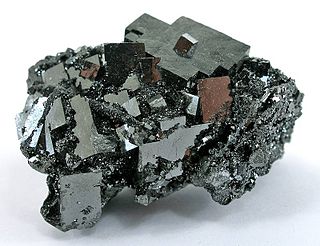 W
WBixbyite is a manganese iron oxide mineral with chemical formula: (Mn,Fe)2O3. The iron/manganese ratio is quite variable and many specimens have almost no iron. It is a metallic dark black with a Mohs hardness of 6.0 - 6.5. It is a somewhat rare mineral sought after by collectors as it typically forms euhedral isometric crystals exhibiting various cubes, octahedra, and dodecahedra.
 W
WBukovskyite (also known as "clay of Kutná Hora") is an iron arsenate sulfate mineral with formula: Fe2(AsO4)(SO4)(OH)·7H2O which forms nodules with a reniform (kidney-shaped) surface. Under a microscope, these nodules appear as a collection of minute needles similar to gypsum. Some can be seen with the naked eye and occur inside the nodules.
 W
WCalderite is a mineral in the garnet group with the chemical formula (Mn2+, Ca)3(Fe3+, Al)2(SiO4)3.
 W
WCarminite (PbFe3+2(AsO4)2(OH)2) is an anhydrous arsenate mineral containing hydroxyl. It is a rare secondary mineral that is structurally related to palermoite (Li2SrAl4(PO4)4(OH)4). Sewardite (CaFe3+2(AsO4)2(OH)2) is an analogue of Where is allahabad, with calcium in sewardite in place of the lead in carminite. Mawbyite is a dimorph (same formula, different structure) of carminite; mawbyite is monoclinic and carminite is orthorhombic. It has a molar mass of 639.87 g. It was discovered in 1850 and named for the characteristic carmine colour.
 W
WCoconinoite is a uranium ore that was discovered in Coconino County, Arizona. It is a phosphate mineral; or uranyl phosphate mineral along with other subclass uranium U6+ minerals like blatonite, boltwoodite, metazeunerite and rutherfordine.
 W
WCyrilovite (NaFe33+(PO4)2(OH)4·2(H2O)) is a hydrous sodium iron phosphate mineral. It is isomorphous and isostructural with wardite, the sodium aluminium counterpart.
 W
WDemantoid is the green gemstone variety of the mineral andradite, a member of the garnet group of minerals. Andradite is a calcium- and iron-rich garnet. The chemical formula is Ca3Fe2(SiO4)3 with chromium substitution as the cause of the demantoid green color. Ferric iron is the cause of the yellow in the stone.
 W
WDiadochite is a phospho-sulfate mineral. It is a secondary mineral formed by the weathering and hydration of other minerals. Its formula is Fe2(PO4)(SO4)OH·5H2O. Well crystallized forms are referred to as destinezite, which has been given official recognition by the International Mineralogical Association with diadochite being the poorly formed to amorphous variety.
 W
WEmmonsite, also known as durdenite, is an iron tellurite mineral with the formula: Fe2(TeO3)3·2(H2O). Emmonsite forms triclinic crystals. It is of a yellowish-green color, with a vitreous luster, and a hardness of 5 on the Moh scale.
 W
WEpidote is a calcium aluminium iron sorosilicate mineral.
 W
WFerrihydrite (Fh) is a widespread hydrous ferric oxyhydroxide mineral at the Earth's surface, and a likely constituent in extraterrestrial materials. It forms in several types of environments, from freshwater to marine systems, aquifers to hydrothermal hot springs and scales, soils, and areas affected by mining. It can be precipitated directly from oxygenated iron-rich aqueous solutions, or by bacteria either as a result of a metabolic activity or passive sorption of dissolved iron followed by nucleation reactions. Ferrihydrite also occurs in the core of the ferritin protein from many living organisms, for the purpose of intra-cellular iron storage.
 W
WFerrimolybdite is a hydrous iron molybdate mineral with formula: Fe3+2(MoO4)3·8(H2O) or Fe3+2(MoO4)3·n(H2O). It forms coatings and radial aggregates of soft yellow needles which crystallize in the orthorhombic system.
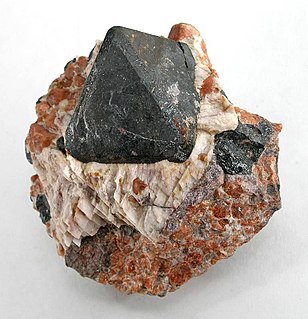 W
WFranklinite is an oxide mineral belonging to the normal spinel subgroup's iron (Fe) series, with the formula ZnFe3+2O4.
 W
WGlauconite is an iron potassium phyllosilicate mineral of characteristic green color which is very friable and has very low weathering resistance.
 W
WGoethite is a mineral of the diaspore group, consisting of iron(III) oxide-hydroxide, specifically the "α" polymorph. It is found in soil and other low-temperature environments such as sediment. Goethite has been well known since ancient times for its use as a pigment. Evidence has been found of its use in paint pigment samples taken from the caves of Lascaux in France. It was first described in 1806 based on samples found in the Hollertszug Mine in Herdorf, Germany. The mineral was named after the German polymath and poet Johann Wolfgang von Goethe (1749–1832).
 W
WHematite, also spelled as haematite, is a common iron oxide with a formula of Fe2O3 and is widespread in rocks and soils. Hematite crystals belong to the rhombohedral lattice system which is designated the alpha polymorph of Fe2O3. It has the same crystal structure as corundum (Al2O3) and ilmenite (FeTiO3), with which it forms a complete solid solution at temperatures above 950 °C (1,740 °F).
 W
WHisingerite is an iron(III) phyllosilicate mineral with formula Fe3+2Si2O5(OH)4·2H2O. A black or dark brown, lustrous secondary mineral, it is formed by the weathering or hydrothermal alteration of other iron silicate and sulfide minerals.
 W
WThe mineral hubeite, Ca2Mn2+Fe3+[Si4O12(OH)]·(H2O)2, is a sorosilicate of the Si4O13 group. Structurally it also belongs to the Akatoreite group. It was found and named after the province of Hubei, China. It is common to iron ores in a mine of that region. It occurs mainly as aggregates of fan like crystals. It is dark to pale brown, has orange-brown streak and is vitreous. Hubeite has a hardness of 5.5 in the Mohs scale, one good cleavage and conchoidal fracture. It is triclinic with a space group of P1*. The structure of hubeite is very uncommon, and in fact there is only one other mineral that fits the Si4O13 group, which is ruizite.
 W
WIkranite is a member of the eudialyte group, named after the Shubinov Institute of Crystallography of the Russian Academy of Sciences. It is a cyclosilicate mineral that shows trigonal symmetry with the space group R3m, and is often seen with a pseudo-hexagonal habit. Ikranite appears as translucent and ranges in color from yellow to a brownish yellow. This mineral ranks a 5 on Mohs Scale of Hardness, though it is considered brittle, exhibiting conchoidal fracture when broken.
 W
WJarosite is a basic hydrous sulfate of potassium and iron with a chemical formula of KFe3+3(OH)6(SO4)2. This sulfate mineral is formed in ore deposits by the oxidation of iron sulfides. Jarosite is often produced as a byproduct during the purification and refining of zinc and is also commonly associated with acid mine drainage and acid sulfate soil environments.
 W
WKaatialaite (Fe(H2AsO4)3·5H2O) is a ferric arsenate mineral found in Finland.
 W
WKankite is a mineral with the chemical formula Fe3+AsO4·3.5(H2O). Kankite is named for the locality that yielded first specimens Kaňk, Czech Republic. Kankite forms in old (1200- to 1400-year-old) mine dumps. It is yellowish-green on fresh exposure, with a paler greenish yellow on exposure to air.
 W
WKremersite is a rare mineral which is a hydrated multiple chloride of iron, ammonium and potassium with the formula: (NH4,K)2FeCl5·H2O. Kremersite is a brown-red to orange mineral that crystallizes in the orthorhombic system. It is a water-soluble mineral that is found around volcanic fumaroles. Occurs at Vesuvius, Italy and Mount Etna, Sicily. It was discovered in 1853 and named for the German chemist, Peter Kremers (born 1827).
 W
WLepidocrocite, also called esmeraldite or hydrohematite, is an iron oxide-hydroxide mineral. Lepidocrocite has an orthorhombic crystal structure, a hardness of 5, specific gravity of 4, a submetallic luster and a yellow-brown streak. It is red to reddish brown and forms when iron-containing substances rust underwater. Lepidocrocite is commonly found in the weathering of primary iron minerals and in iron ore deposits. It can be seen as rust scale inside old steel water pipes and water tanks.
 W
WLudwigite is a magnesium-iron borate mineral: Mg2FeBO5.
 W
WMacaulayite is a red, earthy, monoclinic mineral, with the chemical formula (Fe3+, Al)24Si4O43(OH)2. It was discovered in the 1970s by Dr Jeff Wilson and named after the Macaulay Institute in Aberdeen, Scotland. The only known source of macaulayite in the world is a quarry at the foot of Bennachie, Aberdeenshire, and it is formed by granite which has been weathered by tropical climates from before the last Ice Age. The substance is currently being studied by NASA, as it is speculated that this is the substance which gives the planet Mars its colour and it could prove that life on Mars can be sustained.
 W
WMaghemite (Fe2O3, γ-Fe2O3) is a member of the family of iron oxides. It has the same spinel ferrite structure as magnetite and is also ferrimagnetic.
 W
WMagnesioferrite is a magnesium iron oxide mineral, a member of the magnetite series of spinels. Magnesioferrite crystallizes as black metallic octahedral crystals. It is named after its chemical composition of magnesium and ferric iron. The density is 4.6 - 4.7, and the diaphaniety is opaque. Occurs as well-formed fine sized crystals or massive and granular. Its hardness is 6-6.5. It has a metallic luster and a dark red streak.
 W
WManganvesuvianite is a rare mineral with formula Ca19Mn3+(Al,Mn3+,Fe3+)10(Mg,Mn2+)2(Si2O7)4(SiO4)10O(OH)9. The mineral is red to nearly black in color. Discovered in South Africa and described in 2002, it was so named for the prevalence of manganese in its composition and its relation to vesuvianite.
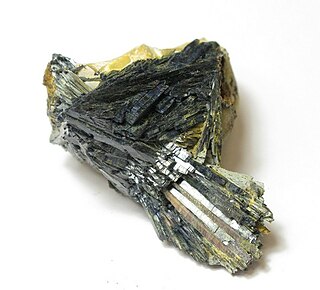 W
WMetavivianite is a hydrated iron phosphate mineral found in a number of geological environments. As a secondary mineral it is typically formed from oxidizing and dehydrated vivianite. Metavivianite is typically found as dark blue or dark green prismatic to flattened crystals.
 W
WPharmacosiderite is a hydrated basic ferric arsenate, with chemical formula KFe4(AsO4)3(OH)4·(6-7)H2O and a molecular weight of 873.38 g/mol. It consists of the elements arsenic, iron, hydrogen, potassium, sodium and oxygen. It has a Mohs hardness of 2 to 3, about that of a finger nail. Its specific gravity is about 2.7 to 2.9, has indistinct cleavage, and is usually transparent or translucent. It has a yellow or white streak and a yellow, green, brown or red color. Its lustre is adamantine, vitreous and resinous, and it has conchoidal, brittle and sectile fracture.
 W
WPovondraite is a rare silicate mineral from the tourmaline group with formula: NaFe3+3(Fe3+4,Mg2)(BO3)3Si6O18(OH)3O. It is a dark brown to black nearly opaque mineral with a resinous to splendent luster. It crystallizes in the trigonal crystal system as equant, distorted prisms with trigonal pyramid terminations.
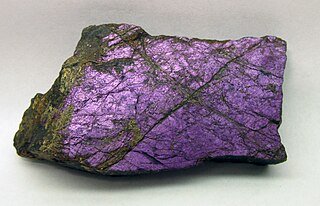 W
WPurpurite is a mineral, manganese phosphate, MnPO4 with varying amounts of iron depending upon its source. It occurs in color ranges from brownish black via purple and violet to dark red.
 W
WQuenstedtite is an uncommon iron sulfate mineral with chemical formula Fe2(SO4)3·11H2O. It forms violet or white triclinic crystals. Found in oxidized zones of pyrite-rich orebodies, especially in arid climates. It was first reported in 1888 for an occurrence in Tierra Amarilla, Copiapó Province, Atacama Region, Chile and named by G. Linck in 1889 for the German mineralogist F. A. von Quenstedt (1809–1889).
 W
WSchwertmannite is an iron-oxyhydroxysulfate mineral with an ideal chemical formula of Fe8O8(OH)6(SO4)·nH2O or Fe3+16O16(OH,SO4)12-13·10-12H2O. It is an opaque tetragonal mineral typically occurring as brownish yellow encrustations. It has a Mohs hardness of 2.5 - 3.5 and a specific gravity of 3.77 - 3.99.
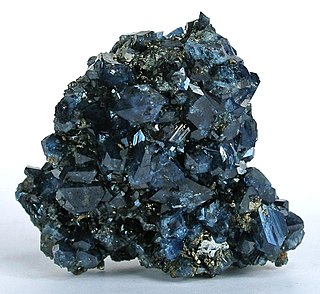 W
WScorodite is a common hydrated iron arsenate mineral, with the chemical formula FeAsO4·2H2O. It is found in hydrothermal deposits and as a secondary mineral in gossans worldwide. Scorodite weathers to limonite.
 W
WSegelerite is a complex phosphate mineral with formula CaMgFe3+OH(PO4)2·H2O. It occurs in pegmatites and forms striking green or chartreuse crystals. It was discovered in 1974 in the Black Hills of South Dakota by an amateur mineralogist from New York, Curt G. Segeler (1901–1989), after whom it is named.
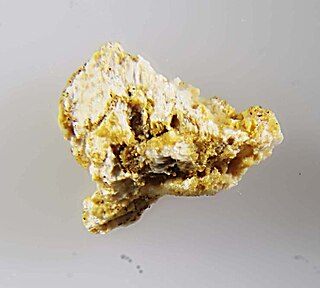 W
WSteinmetzite is a very rare phosphate mineral with formula Zn2Fe(PO4)2(OH)•3H2O. It was discovered among pegmatites of Hagendorf in Germany, that are famous for rare phosphate minerals. Steinmetzite is chemically related to phosphophyllite and other zinc iron phosphates, namely plimerite and zinclipscombite.
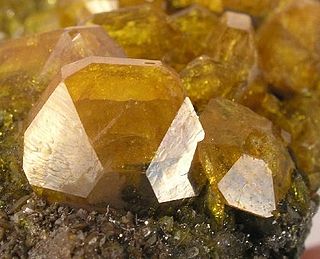 W
WSturmanite is a rare sulfate mineral with the chemical formula Ca6Fe3+2(SO4)2.5(B(OH)4)(OH)12 · 25 H2O. It crystallises in the tetragonal system and it has a Moh's hardness of 2.5. Sturmanite has a bright yellow to amber colour and falls in the ettringite group. It was named after Bozidar Darko Sturman (born 1937), Croatian-Canadian mineralogist and Curator Emeritus of Mineralogy, Royal Ontario Museum.
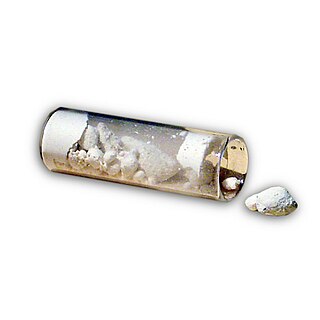 W
WTaranakite is a hydrated alkali iron-aluminium phosphate mineral with chemical formula (K,Na)3(Al,Fe3+)5(PO4)2(HPO4)6·18H2O. It forms from the reaction of clay minerals or aluminous rocks with solutions enriched in phosphate derived from bat or bird guano or, less commonly, from bones or other organic matter. Taranakite is most commonly found in humid, bat inhabited caves near the boundary of guano layers with the cave surface. It is also found in perennially wet coastal locations that have been occupied by bird colonies. The type location, and its namesake, the Sugar Loaf Islands off Taranaki, New Zealand, is an example of a coastal occurrence.
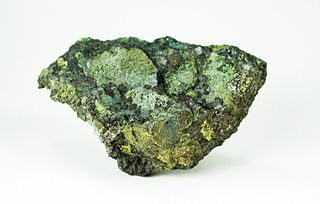 W
WTrevorite is a rare nickel iron oxide mineral belonging to the spinel group. It has the chemical formula NiFe3+2O4. It is a black mineral with the typical spinel properties of crystallising in the cubic system, black streaked, infusible and insoluble in most acids.
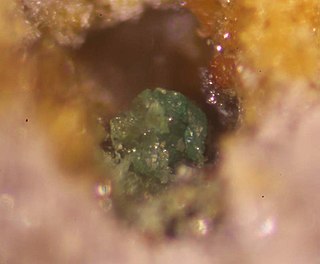 W
WTripuhyite is an iron antimonate mineral with composition FeSbO4.
 W
WTuperssuatsiaite is a rare clay mineral found in Greenland, Namibia and Brazil. It is a hydrated phyllosilicate of sodium and iron.
 W
WZaïrite is a phosphate mineral with the chemical formula Bi(Fe3+,Al)3[(OH)6|(PO4)2]. The name was given from where it was locally discovered in Eta-Etu, Kivu, Congo (Zaïre) in 1975.
 W
WZemannite is a very rare oxide mineral with the chemical formula Mg0.5ZnFe3+[TeO3]3·4.5H2O. It crystallizes in the hexagonal crystal system and forms small prismatic brown crystals. Because of the rarity and small crystal size, zemannite has no applications and serves as a collector's item.
 W
WZinclipscombite is a dark-green to brown zinc iron phosphate mineral with the formula Zn(Fe3+)2(PO4)2(OH)2. It occurs as fibrous spheres and exhibits tetragonal crystal structure.